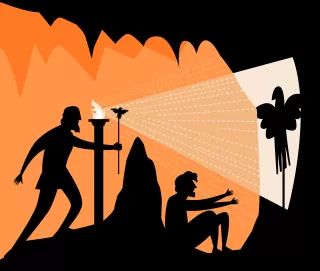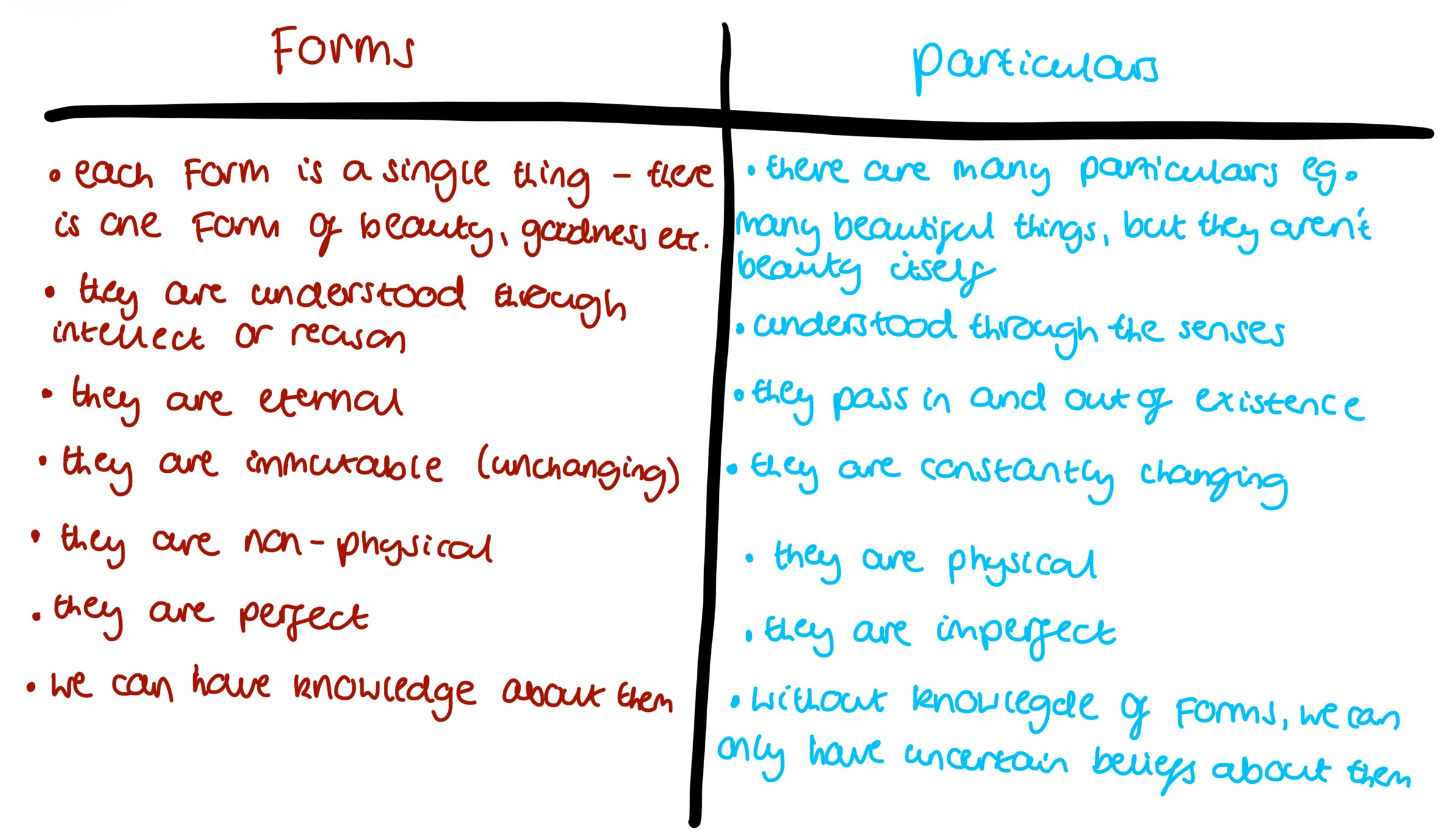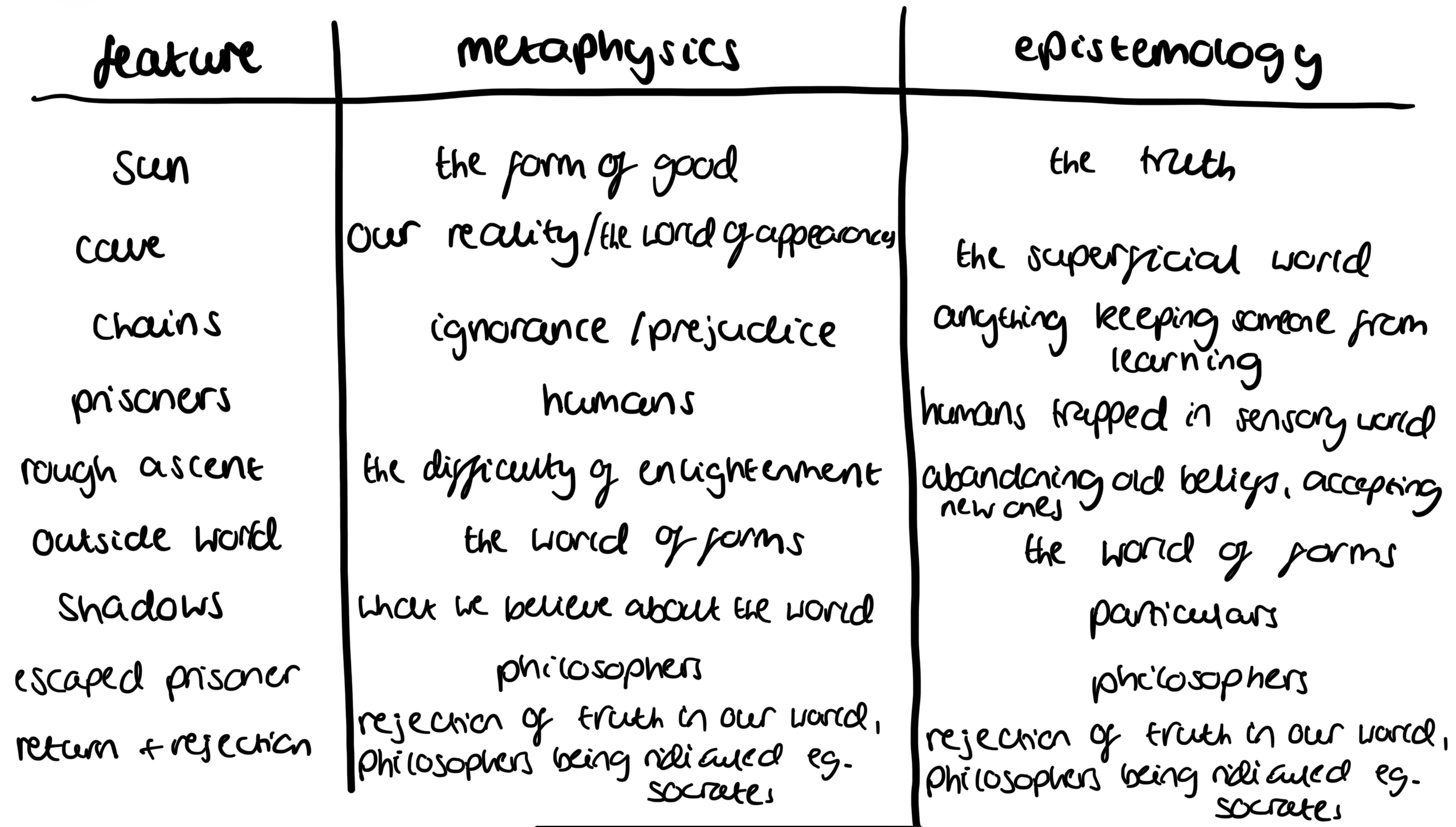Plato
1/12
There's no tags or description
Looks like no tags are added yet.
Name | Mastery | Learn | Test | Matching | Spaced |
|---|
No study sessions yet.
13 Terms
Who were Plato’s influences?
Socrates (470 - 399 BCE)
Socratic questioning - asking questions to refine our understanding of a concept
‘All I know is that I know nothing’
Knowledge (episteme) vs opinion (doxa) - through Socratic questioning, he seeks to bring people from a state of belief to a state of knowledge
Heraclitus (circa 500 BCE)
‘Can you step into the same river twice?’
Flux - everything is undergoing a constant process of change
Challenges the possibility of knowledge - if everything is changing, and knowledge is something permanent, how can we know anything at all?
Unity of opposites - something can be both big and small at the same time (depends what you are comparing it to)
Pythagoras (570 - 495 BCE)
Proportion - he studied the mathematics underlying shapes and musical harmony
Mathematics as fundamental - for Pythagoras, the underlying nature of the universe is mathematics
Soul separate from body - he is a dualist (believes in a separate mind and body - the mind is non-physical)
What problem is Plato trying to solve?
The problems of epistemology (the study of knowledge)
How can we have knowledge of anything?
What is the nature of knowledge?
Is knowledge a priori or a posteriori?
According to Plato, all knowledge a posteriori is questionable (perhaps because people have different experiences, and conclude different things from those experiences)
What is the allegory of Plato’s cave?
There are a group of people in a cave, chained in place staring straight at a wall, that have been there their entire life
There is a big fire behind them, and a low partition which is used to conceal the people (something like puppeteers) during their ‘show’
The people carry objects, like carved images of people and animals, back and forth so that they create shadows on the prisoners’ wall - sometimes the people add sounds
The captives would think this shadow realm to be the truth
If one was set free, he would find it painful to look upon the fire (representing the painful road of enlightenment) , and would wish to go back to believing in the shadows
If he went outside the cave, it would take time for him to get used to the sunlight, but eventually he would learn the truth of the world and be able to look at the sun (the form of good) - he would then pity for the other captives
Perhaps the captives had prizes for who recognised the shapes of the shadows the best - but the freed man would no longer desire these prizes or to go back to that life
If he did go back, his eyes would take a while to adjust and the others would surely mock him for his ruined eyes and try to kill him

What are the 2 interpretations of Plato’s cave?
Politics: most people don’t understand what justice is and are manipulated by politicians who conceal the truth from them and feed them half-truths (the shadows in the cave)
Epistemology (theory of knowledge): the world we see is a world of shadows, and behind it there is a deeper reality of Forms - philosophers are like the man who is freed and sees the truth (possibly a reference to Socrates, the enlightened being killed by the ignorant)
Explain Plato’s theory of Forms (Eidos)
How do we know that all the examples of beauty that we can think of are beautiful? Plato would say it’s because we understand the idea of beauty as a universal - this allows us to recognise a lot of beautiful things
A universal is something shared between many things in a category eg. There are many particular, beautiful things but they all share in the universal property of beauty
Plato believed the idea of beauty existed in a separate reality from our material world of particulars (things like particular tables, examples of justice, etc)
There is a separate realm of Forms which, for Plato, we need to study in order to have genuine knowledge (the ‘knowledge’ we have of particulars is just opinion) - in the realm of Forms blueness, a table, beauty, justice, a human, exist as ideal concepts
Explain Plato’s 3 arguments for the Forms
The argument from perfection: we have knowledge of what it is for something to be a perfect circle, but we have never experienced a perfectly circular circle - therefore, since we have a knowledge, there must be an ideal perfect circle that exists independently of the material world (in the world of Forms)
The argument from memory (anamnesis): We have the capacity to figure things out without being directly told them (eg. In Meno, Plato shows how a slave boy can discover things about geometry without being taught them) and this shows we must be born with an innate knowledge of the world of Forms - our souls previously existed in a separate world, but when it was born into this world is forgot the knowledge it had of the world of Forms. Through intellectual discipline we can remember things about the world of Forms and thus regain knowledge (process called anamnesis)
The one-over-many argument: There are many particular beautiful things, and are all different - given an example of something beautiful, we can recognise as such. This means there must be a form of Beauty itself - when we recognise a particular thing as beautiful, we are recognising that it is a shadow in the Form of Beauty (you replace ‘beauty’ in this argument with any property, ‘good’, ‘blue’)
Name some features of Forms and Particulars

What are the strengths of Plato’s theory of Forms?
It makes sense and provides a possible answer to the issues raised in his arguments
Simple and easy to understand and conceive of
It has strong arguments to back it up
It forces us to question things
It explains why the world is imperfect
Forms explain how we can talk about general properties like beauty/justice
Empirical/a posteriori beliefs do seem unreliable (optical illusions, eg. Descartes’ evil demon)
What are the weaknesses of Plato’s theory of Forms?
there is no evidence that his answer is the correct one, it is one explanation but there are many more that are just as plausible (lacking in empirical evidence)
Explain the 4 messages of the cave analogy
Metaphysics (what is real?): This world, the realm of appearances, isn’t real (the cave). The realm of the Forms is real as it is purely rational and not dependent on sense experience (the outside world)
Epistemology (how do we gain knowledge?): Go beyond our comfort zone and what we usually accept, go on the hard journey to discover the Realm of Forms. Escaped prisoner and the rough ascent. Knowledge is gained through the mind/reason (a priori) and not through the senses (a posteriori). Senses are only opinion.
Politics (who should rule?): The philosopher (the escaped prisoner) is the only one who had the knowledge and power to rule. Democracy puts power into the hands of the majority, who do not have knowledge
Ethics (what is good?): Only the philosopher who sees the Form of Good can understand what goodness is. It is the pinnacle of truth. It is hard to look at and understand. (The escaped prisoner is ‘dazzled’ by the light of the sun)
Explain what these features of the analogy represent for the metaphysical and epistemological interpretations: Sun, Cave, Chains, Prisoners, Rough ascent, Outside world, Shadows, Escaped prisoner, Return + rejection

The Form of the Good: which argument does it align with, what is it and how does it affect us?
argument from perfection
Source of all goodness - it allows us to have knowledge of the other forms
Metaphor of the sun
Top of the hierarchy of forms (good —> concepts like beauty/justice —> forms of phenomena —> objects like chairs)
One who has grasped the ‘form of the good’ is incapable of doing wrong
Explain Plato’s Sun Metaphor
Plato’s sun metaphor illustrates Plato’s idea that there is a single ‘Form of the Good’ which illuminates the other Forms. It is source of all knowledge: it makes all the other forms knowable to us (makes it possible for us to know them), just as the sun makes external objects visible to us (makes it possible for us to know them). It is the most perfect form in existence.